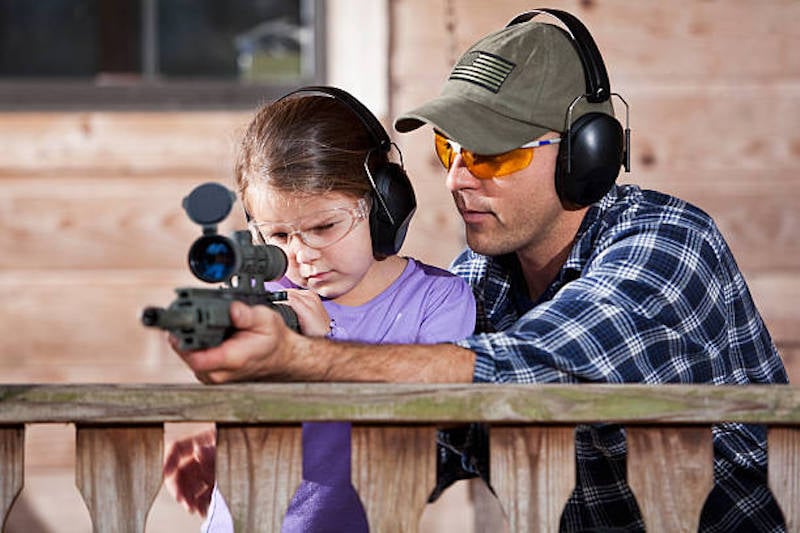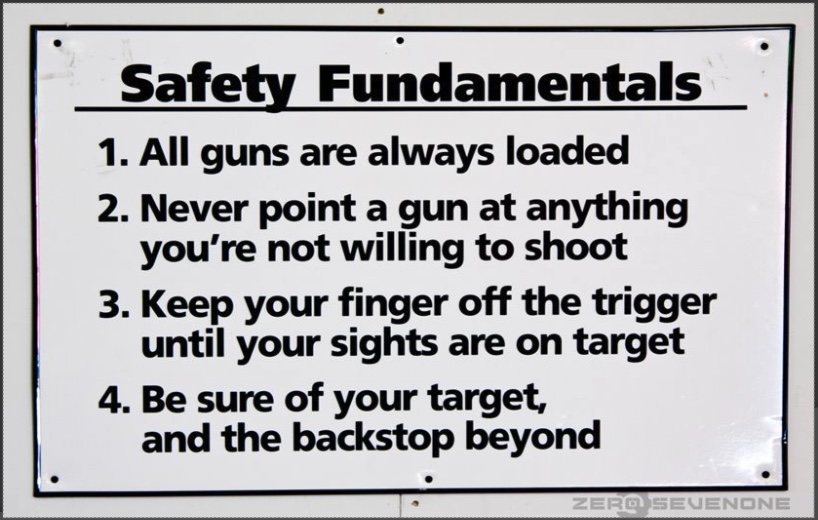As a firearms owner, instructor, and father of three, gun safety in our household is not an option. It’s as important as reading, writing, and arithmetic, not to mention studying history and the Constitution. If you’re like me and have kids and an assortment of firearms in your home, teaching the kids how to handle a gun safely is a matter of life and death.
Too many tragedies happen because kids discover a gun somewhere, their curiosity gets the best of them, and they pull the trigger to disastrous consequences. Providing kids with proper education and training can empower them to make informed decisions and handle firearms responsibly, should they encounter them in the future. It also helps orient them into the world of firearms that they can enjoy as they get older and prepare to protect themselves.

Gun Safety: How Old?
One question that always arises early in the discussion is, “How old should my kids be before we teach them gun safety?” A second, hidden question often lives just below the surface: “How old should my kids be before I teach them how to shoot?” It’s easy to confuse these two questions or even to think they are the same, but they are not.
Kids can learn about gun safety long before they are old enough to pull a trigger. For example, our littlest, who is now ten years old, started learning about guns when she was seven by discussing it with me as I was in the basement one afternoon cleaning a pistol. She knew I carried a gun all the time and that I taught classes, so she started asking me questions in typical kid fashion.
We started by discussing the responsibility of holding a gun and what it can do. We then moved on to the four fundamental rules of gun safety. Finally, I took the pistol I had just cleaned, which was unloaded, faced her toward the concrete basement wall, and had her hold it up, careful to keep her finger off the trigger. As expected, it was a bit too big and heavy for her little hands, so she carefully handed it back to me after only a moment. That was her intro to guns. She didn’t fire her first shot until a year later when she was big enough to hold my Henry .22 LR rifle by herself.
The older two kids, a girl and a boy who are now teenagers, had similar journeys. Now, all three shoot with me. My youngest has even graduated to the AR-15, which is her favorite gun. Go figure.
The Basics of Gun Safety
When introducing kids to firearms, start with the absolute basics. Teach them to always treat every firearm as if it is loaded, even if they know it is not. Emphasize the importance of never pointing a firearm at anything they do not intend to shoot and keep their finger off the trigger until they are ready to shoot.

Gun Safety with an Emphasis on Children
Teach Respect for Firearms
Instilling respect for firearms is crucial in firearms training for kids. Teach them that firearms are not toys and should never be handled casually or without adult supervision. Emphasize the seriousness of firearms and the potential consequences of mishandling them.
Always Supervise
One of the most important rules of firearms training for kids is to always supervise them closely when they are handling firearms. Never leave kids unattended with firearms, even if they have received prior training. Adult supervision is essential to ensure that kids follow safety protocols and handle firearms responsibly.
Emphasize Safe Storage
Teach kids the importance of safe firearm storage practices. Firearms should always be stored securely in a locked cabinet or safe. Kids should not have access to firearms unless under direct adult supervision. In our house, only my wife and I know how to get into the gun safes.
Use Age-Appropriate Firearms
When introducing kids to firearms, use age-appropriate firearms that are suitable for their size, strength, and skill level. Start with firearms that are easy to handle and understand, such as air rifles or .22 caliber rifles, before progressing to larger or more complex firearms.
Provide Proper Training
Teaching your own kids is a start, but enrolling them in reputable firearms training programs taught by qualified instructors can fill in the gaps you might miss. Plus, it’s good to hear it from someone besides their parents. These programs should cover firearm safety, handling, marksmanship, and the legal and ethical responsibilities of gun ownership. Additionally, parents should supplement formal training with ongoing education and practice sessions at home.
Teach Conflict Resolution and De-escalation
In addition to firearm skills, teach kids conflict resolution and de-escalation techniques. Emphasize the importance of communication, empathy, and seeking help from adults or authorities when faced with a potentially dangerous situation.
Practice Regularly
Regular practice is essential to maintain proficiency and reinforce safety protocols. Schedule regular practice sessions at a safe and appropriate location, such as a shooting range or private property with a designated shooting area. Use these sessions to review safety procedures and improve marksmanship skills under adult supervision.
Set a Positive Example
Parents and adult mentors should set a positive example regarding firearm safety and responsible gun ownership. Follow all safety protocols, store firearms securely, and demonstrate proper handling and shooting techniques. Kids are more likely to emulate responsible behavior when they see it consistently modeled by adults.
Address Curiosity and Questions
Encourage open communication with kids about firearms. Answer their questions honestly and age-appropriately, addressing any curiosity they may have about firearms. Foster a safe and non-judgmental environment where kids feel comfortable discussing firearms-related topics.
Parting Shots
Gun safety for kids requires a comprehensive approach that prioritizes safety, education, and responsible gun ownership. Ultimately, the goal is to instill a lifelong commitment to firearms safety and responsible gun ownership in kids.


